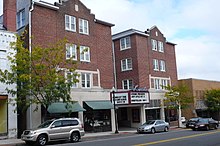
Marion is a town in and the county seat of Smyth County, Virginia, United States. Conveniently positioned upon Interstate 81, Marion is easily accessible. Located in the Blue Ridge portion of the Southern Appalachian mountains in Southwest Virginia, the general Marion area is well known for its scenic beauty. The town is named for American Revolutionary War officer Francis Marion. The town limits had a population of approximately 6,000, per 2020 Census estimates. However, an additional 9,000 residents in unincorporated Smyth County have Marion mailing addresses, giving the Marion, VA ZIP code (24354) a population of over 15,000, which is about half of the county's total population.

Buildings, sites, districts, and objects in Virginia listed on the National Register of Historic Places:
The Illinois Historic Preservation Division, formerly Illinois Historic Preservation Agency, is a governmental agency of the U.S. state of Illinois, and is a division of the Illinois Department of Natural Resources. It is tasked with the duty of maintaining State-owned historic sites, and maximizing their educational and recreational value to visitors or on-line users. In addition, it manages the process for applications within the state for additions to the National Register of Historic Places.

The Attucks Theatre, located in Norfolk, Virginia, United States, was financed, designed and constructed by African American entrepreneurs in 1919. The theatre was designed by Harvey Johnson, an African-American architect. The theatre was named in honor of Crispus Attucks, an African American who was the first patriot to lose his life in the Revolutionary War. When it was first opened, Attucks Theatre was known as the "Apollo Theatre of the South." It has hosted performers ranging from Cab Calloway to Redd Foxx. The theater hosted numerous famous entertainers through the 1920s, 1930s, 1940s and early 1950s, including Norfolk's Gary U.S. Bonds and Portsmouth's Ruth Brown.

Leesylvania State Park is located in the southeastern part of Prince William County, Virginia. The land was donated in 1978 by philanthropist Daniel K. Ludwig, and the park was dedicated in 1985 and opened full-time in 1992.

Grace Hospital is an American historic hospital in Richmond, Virginia. The original Colonial Revival structure was built in 1911 based on a design by noted Virginia architect Charles M. Robinson. The hospital is located to the west of Richmond's central business district and was substantially expanded by additions in 1930 and 1964. The original three-story main structure with an entrance pavilion on West Grace Street, is a Colonial Revival building with paired Ionic order columns and gauged arches. In 1930, a five-story Moderne style addition was built to the south along Monroe Street. In 1964, a further three-story addition was built along Grace Street. The 1964 addition is devoid of ornamentation, and the west wing "projects a modern, utilitarian character."

Onancock Historic District is a national historic district located at Onancock, Accomack County, Virginia. The district encompasses 267 contributing buildings, 2 contributing sites, and 2 contributing objects. It includes most of the historic residential, commercial, and ecclesiastical buildings in the town of Onancock. The buildings represent a variety of popular architectural styles including the Late Victorian, Greek Revival, and Federal styles. Notable buildings include Scott Hall, Alicia Hopkins House (1830), Harmon House, Holly House (1860), Ingleside (1880s), Dr. Lewis Harmanson House (1899), Harbor Breeze (1912), First National Bank, Roseland Theatre, Market Street Methodist Church (1882), Naomi Makemie Presbyterian Church (1895), the Charles E. Cassell designed Holy Trinity Episcopal Church (1882), Onancock Town Hall, Onancock High School (1921), and Onancock Post Office (1936). Located in the district and separately listed are the Cokesbury Church, Hopkins and Brother Store and Kerr Place.

Clifton Forge Commercial Historic District is a national historic district located at Clifton Forge, Alleghany County, Virginia. The district encompasses 77 contributing buildings in the central business district of Clifton Forge. It primarily includes frame, brick, and concrete block commercial buildings dating to the late-19th and early-20th centuries. The buildings are in a variety of popular architectural styles including Classical Revival, Mission/Spanish Revival, and Italianate. Notable buildings include the Hawkins Brothers Store, Wiley House (1891), Chesapeake and Ohio Office Building (1906), Masonic Theatre (1905), Alleghany Building (1905), Clifton Forge City Hall (1910-1911), U.S. Post Office (1910), Ridge Theatre (1929), the Farrar Building (1930), and the Pure Oil Company Service Station (1932).

Colonial Village is a historic garden apartment complex located at Arlington County, Virginia, United States. It contains 226 contributing buildings built in four stages between 1935 and 1940. The buildings hold approximately 1,055 apartments. The brick Colonial Revival-style buildings are situated around courtyards with clusters of five and seven buildings to larger groupings of up to thirteen. Colonial Village was the first Federal Housing Administration-insured, large-scale, rental housing project erected in the United States. The complex has been converted to condominiums split into three phases and two apartment complexes: Colonial Village Apartments and Colonial Village West.

Gordon C. Felts House is a historic home located at Galax, Virginia. It was completed in 1930, and is a large 2 1/2-story stuccoed brick dwelling in the Mission Revival style. It features a terra cotta mission style gabled roof. It also has a large bluestone terrace covered by a pergola supported by six large Grecian Doric order columns, on the south side the house has an enclosed sleeping porch defined with four large Grecian Doric columns. Also on the property are a contributing garage / apartment and playhouse. Currently owned by Nancy and Dr. Samuel B. Luague.
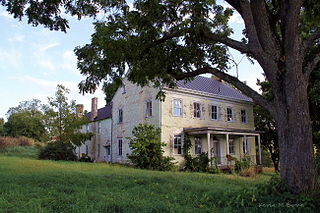
Lincoln Homestead and Cemetery, also known as the Jacob Lincoln House, is a historic home and cemetery located near Broadway, Rockingham County, Virginia. It was built in two sections. The main section was built about 1800, and is a two-story, five bay, brick structure with a side gable roof. It features an elaborate wooden cornice with Wall-of-Troy molding, corbels and dentils, and a Federal style doorway. The two-story brick rear ell was built in 1849 and joined to the main house in the early-1900s. Located on the property is the Lincoln family cemetery in which are buried five generations of the family, as well as Queenie, a woman who was enslaved by the Lincoln family, and "Virginia John" Lincoln, great-grandfather of Abraham Lincoln.

Preston House, also known as Herondon and the John Montgomery Preston House, is a historic home located near Marion, Smyth County, Virginia. It was built in 1842, and is a two-story, five bay, brick Federal style dwelling. It features two closely matched doorways with a transom and sidelights, framed and divided by slender Tuscan order columns with an entablature and Greek Revival block composition above. The house was built "as a tavern or stagecoach inn along the Wilderness Road." This inn served travellers for some 22 years until 1864.

Marion Historic District is a national historic district located at Marion, Smyth County, Virginia. The district includes 361 contributing buildings, 2 contributing sites, and 1 contributing object in the central business district and surrounding residential areas of Marion. It includes a variety of residential, commercial, institutional, industrial, and governmental buildings primarily dating from the mid-19th to mid-20th centuries. Notable buildings include the Sheffey Loom House, Odd Fellows Lodge, Look & Lincoln Wagon Factory warehouse, the Beaux-Arts style Marion County Courthouse (1905), Mt. Pleasant Methodist Church, Courtview Building (1890s), Marion High School (1907-1908), Marion Junior College (1912), the Overall Factory, Weiler Building, Bank of Marion (1922), Royal Oak Presbyterian Church (1923), Marion Municipal Building (1935), Marion Post Office (1936), and a Lustron house (1948). Also located in the district are the separately listed Hotel Lincoln, Lincoln Theatre, Marion Male Academy, and Norfolk & Western Railway Depot.

Hotel Lincoln, also known as the General Francis Marion Hotel and Lincoln Inn, is a historic hotel building located at Marion, Smyth County, Virginia. It was built in 1926–1927, and is a five-story, Colonial Revival style reinforced concrete commercial building. The upper floors are faced with Kingsport velveteen brick. The third through fifth floors are "U" shaped and contain 19 guestrooms and 13 bathrooms per floor. It is one of the last remaining early-20th-century hotel buildings in Southwest Virginia. In addition to providing accommodations, the hotel offered space for public and private meetings, receptions, and dances. The building also contained a drugstore, coffee shop, beauty salon, and barber shop.
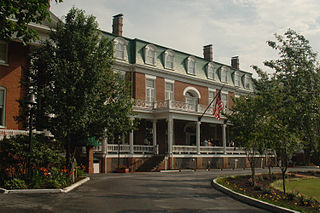
Abingdon Historic District is a national historic district located at Abingdon, Washington County, Virginia. The district encompasses 145 contributing buildings, 2 contributing site, and 13 contributing structures in the town of Abingdon. It includes a variety of residential, commercial, and institutional buildings dating from the late-18th century to the mid-20th century. Notable contributing resources include Sinking Spring Cemetery, William King High School (1913), General Francis Preston House (1832), Martha Washington Inn, Barter Theatre, the Virginia House, Alexander Findlay House (1827), Gabriel Stickley House, Ann Berry House, Washington County Courthouse (1868), Rev. Charles Cummings House, and James Fields House (1857). Located in the district and separately listed are the Abingdon Bank and Dr. William H. Pitts House.

Sanders Farm is a historic home and farm located at Max Meadows, Wythe County, Virginia. The Brick House was built about 1880, and is a two-story, "T"-shaped, Queen Anne style brick farmhouse. It features ornamental gables and porches. Also on the property are the contributing cold frame with a stepped front parapet, a vaulted stone spring house, a one-story brick servants quarters, a cinder block store with an upstairs apartment and an accompanying privy (1950s), a frame vehicle repair shop, a stone reservoir (1880s) two corn crib, a frame gambrel-roofed barn, a one-story tenant house, stone bridge abutments, and the site of the Hematite Iron Company Mine, a complex of rock formations and tram line beds.
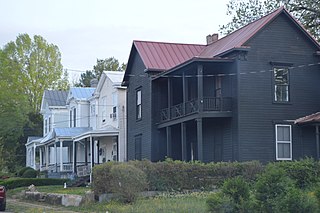
Holbrook–Ross Street Historic District is a national historic district located in Danville, Virginia. The district includes 107 contributing buildings in a primarily African-American neighborhood of Danville. It includes a full range of late 19th and early 20th century residential, commercial, and institutional structures. The majority of the houses are single-family dwellings that were built between 1880 and 1910, and includes notable examples of vernacular Italianate and Queen Anne styles. Notable buildings include the Williams House, Hargraves-Geary House, Tisden House, Leroy Johnson House, Broadnax Apartment, Calvary Baptist Church (1896), Holbrook Street Presbyterian Church, Loyal Baptist Church (1924), Wesley AME Church (1939), Westmoreland Middle School (1936), and the Annex Building (1925). Located in the district are the separately listed Hotel Danville and the Danville Municipal Building.

Thomas Wallace House is a historic home located at Petersburg, Virginia. It was built about 1855, and is a two-story, three-bay, pressed brick dwelling in the Italianate style. It sits on a raised basement and has a low hipped roof with bracketed cornice. It has a one-story rear service wing and a front porch supported by six fluted Greek Doric order columns. On April 3, 1865, President Abraham Lincoln and General Ulysses S. Grant met in its library to discuss the inevitable end to the American Civil War and the surrender.

Centre Hill Historic District is a national historic district located at Petersburg, Virginia. The district includes 81 contributing buildings located in a predominantly residential section of Petersburg. It includes a varied collection of early-19th-century to early-20th century houses and includes notable examples of Greek Revival, Italianate, Colonial Revival, and Bungalow style architecture. Notable buildings include the Centre Hill Apartment Building (1915), Eichberg House, Powell House, Unger House, and St. Joseph's Convent. Located in the district and separately listed is the Centre Hill Museum.
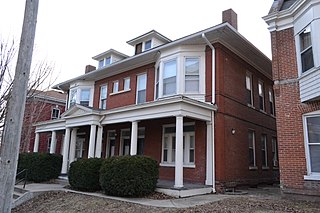
Virginia Flats, also known as the Summit Place Flats, are two historic apartment buildings located at St. Joseph, Missouri. They were designed by the architectural firm Eckel & Mann. The south building was built in 1901, and is a two-story, rectangular Colonial Revival style brick four-plex with a hipped roof and a full-length, one-story front porch. The north building was built in 1888, and is a larger two-story rectangular brick Queen Anne style apartment building with 14 apartments, 7 on each floor.
